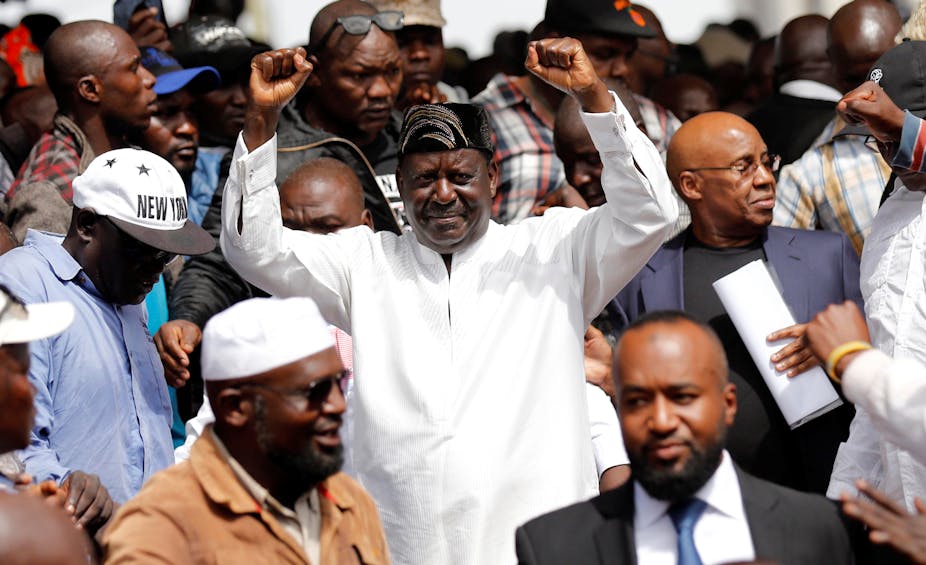In what some have called a coup, Kenya’s opposition leader Raila Odinga was hastily sworn in in a mock ceremony as the “people’s president” by two lawyers in the presence of a sizeable crowd.
The brief January 30 ceremony took place in central Nairobi’s largest park. But this was not a coup. Odinga did not purport to assume the constitutional office of the president held by his rival Uhuru Kenyatta. As some of his supporters have argued, this swearing-in was largely symbolic.
Odinga’s vocal support mirrors the ethnic affiliations of his opposition coalition partners – mostly the Luo, Luhya, Kamba and a number of tribes from the country’s coastal areas. Ranged against them are Kenyatta’s Kikuyu and Deputy President William Ruto’s Kalenjin ethnic groups. These two ethnic groups have produced all the country’s presidents since independence 54 years ago. The Kikuyu, who have produced three of the last four presidents, are the most populous ethnic group in Kenya. They are followed by the Luhya, Kalenjin and Luo.
Grievances over land between the Kikuyu and Kalenjin have previously sparked violent clashes, including post-election carnage in 2007 and 2008. But rattled by International Criminal Court charges over the violence, Kenyatta and Ruto closed ranks to win the next election in 2013.
The two ethnic groups have been accused of exclusionary politics due to their superior numbers, wealth, state power and
and impunity.
Against this backdrop, the events of January 30 could be read as part of Kenya’s long transition to democracy and the push to reclaim the stalled nation building project.
Not a power grab
Kenya has a vibrant modern economy, but remains deeply fractured along ethnic lines.
After independence, Uhuru’s father Jomo Kenyatta preferred the free market model. This gave precedence to private capital and private land tenure regardless of the prevailing inequalities between different ethnic groups.
The senior Kenyatta intimidated Jaramogi Odinga and others who challenged his model. The senior Odinga, who was Kenyatta’s first vice-president and ally turned foe, preferred a land redistribution model. This would have addressed the land and nationhood crisis that continues to date.
The younger Kenyatta has yet to address the mess his father created in the land tenure system. Odinga on the other hand continues his father’s campaign for a more equitable sharing of resources. He has also called for a reformed electoral system which would guarantee equal chances for different ethnic groups to assume the presidency regardless of their size.
Odinga’s swearing-in did not amount to a power grab nor replace the current president. It was more an assertion of people’s power to reject a political model in which opposition supporters’ votes don’t seem to count.
In my view, the message is that while Kenyatta occupies the office of head of the sovereign state, opposition supporters can choose who to legitimise as their president in their own way. The huge crowd that gathered at Uhuru Park fulfilled this mission.
But converting his people power from the popularity contest to real power is the challenge. People power works where the regime in power lacks support. But Kenyatta enjoys as much support as Odinga in the capital.
What next for Raila Odinga?
Odinga has run for president four times – in 1997, 2007, 2013 and 2017 – and lost in all. Some analysts have suggested that the scale and nature of illegalities in the 2007 and 2013 elections are proof that the outcomes were predetermined and the results rigged to keep Odinga out. The August 8 2017 election was also nullified over illegalities and irregularities.
Win or lose, Odinga has been at the centre of the Kenyan political story for decades. His latest actions provoked a fierce reaction from government which took the unprecedented step of shutting out the main TV stations. Several arrests have also been made.
The jury is still out on whether Odinga’s show of power through numbers actually matters. The symbolic ceremony seems to have reduced tensions among his supporters who longed to ‘crown their king’.
The tough talking Kenyatta government has interpreted the swearing-in ceremony as a criminal offence. The furious reaction has further deepened the divisions between government and opposition and also among their supporters. A middle ground where both sides address past injustices and review the relevance of the first-past-the-post electoral system in Kenya that privileges populous ethnic groups over minority ones is what Kenya needs.
As a way forward, dialogue between the people’s president and President of the Republic should start immediately to address the exclusion and entitlement that has prevented Kenya’s nation-building project from taking off.

